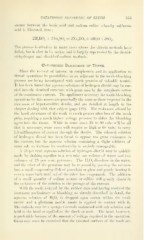Page 557 - My FlipBook
P. 557
:
CATAPHORIC BLEACHING OF TEETH. 555
ensues between the boric acid and sodium sulfite whereby sulfurous
acid is liberated, thus
2H3BO3 -f 3Xa,S03 = 2Xa3B03 + 3H,0 +3SO2.
The process is eiFective in many cases where the chlorin methods have
failed, but is slow in its action and is largely superseded by the dioxid-
of-hydrogen and dioxid-of-sodium methods.
Cataphoric Bleaching of Teeth.
Since the revival of interest in cataphoresis and its application to
dental operations its possibilities as an adjuvant in the tooth-bleaching
process are being investigated with much promise of valuable results.
It has been found that aqueous solutions of hydrogen dioxid may be car-
ried into the dentinal structure with great ease by the cataphoric action
of the continuous current. The appliances necessary for tooth-bleaching
operations by this means are practically the same as those required in the
treatment of hypersensitive dentin, and are detailed at length in the
chapter dealing with that subject (page 189). The resistance oifered by
the hard structures of the tooth is much greater after loss of the tooth
pulp, requiring a much higher voltage pressure to drive the bleaching
agent into the tissue. While in some cases 25 to 30 volts will be all
that is necessary, some cases will require as high as 60 volts to carry
1.5 milliamperes of current through the dentin. The ethereal solution
of hydrogen dioxid has been found to oppose too great resistance to
the current, but the aqueous solution containing a slight addition of
some salt to increase its conductivity is entirely manageable.
A 25 per cent, aqueous solution of hydrogen dioxid may be quickly
made by shaking together in a test tube one volume of water and two
volumes of 25 per cent, pyrozone. The H^O^ dissolves in the water,
and the ether of the pyrozone may be removed by pouring the mixture
into a small evaporating dish of porcelain or glass and gently heating it
over a water batli until all of the ether has evaporated. The addition
of a small quantity of sodium acetate or sulfate will greatly diminish
the resistance of the solution to the passage of the current.
With the tooth isolated by the rubber dam and having received the
treatment preliminary to bleaching, as already described in detail, the
aqueous solution of H^O, is dropped upon cotton within the tooth
cavity and a platinum needle anode is applied in contact with it.
The cathode may be a sponge electrode moistened with salt solution and
held in the hand or applied to the cheek or neck. The hand, however,
is preferable because of the amount of voltage required in the operation.
Great care must be exercised that the external surfaces of the tooth are
CATAPHORIC BLEACHING OF TEETH. 555
ensues between the boric acid and sodium sulfite whereby sulfurous
acid is liberated, thus
2H3BO3 -f 3Xa,S03 = 2Xa3B03 + 3H,0 +3SO2.
The process is eiFective in many cases where the chlorin methods have
failed, but is slow in its action and is largely superseded by the dioxid-
of-hydrogen and dioxid-of-sodium methods.
Cataphoric Bleaching of Teeth.
Since the revival of interest in cataphoresis and its application to
dental operations its possibilities as an adjuvant in the tooth-bleaching
process are being investigated with much promise of valuable results.
It has been found that aqueous solutions of hydrogen dioxid may be car-
ried into the dentinal structure with great ease by the cataphoric action
of the continuous current. The appliances necessary for tooth-bleaching
operations by this means are practically the same as those required in the
treatment of hypersensitive dentin, and are detailed at length in the
chapter dealing with that subject (page 189). The resistance oifered by
the hard structures of the tooth is much greater after loss of the tooth
pulp, requiring a much higher voltage pressure to drive the bleaching
agent into the tissue. While in some cases 25 to 30 volts will be all
that is necessary, some cases will require as high as 60 volts to carry
1.5 milliamperes of current through the dentin. The ethereal solution
of hydrogen dioxid has been found to oppose too great resistance to
the current, but the aqueous solution containing a slight addition of
some salt to increase its conductivity is entirely manageable.
A 25 per cent, aqueous solution of hydrogen dioxid may be quickly
made by shaking together in a test tube one volume of water and two
volumes of 25 per cent, pyrozone. The H^O^ dissolves in the water,
and the ether of the pyrozone may be removed by pouring the mixture
into a small evaporating dish of porcelain or glass and gently heating it
over a water batli until all of the ether has evaporated. The addition
of a small quantity of sodium acetate or sulfate will greatly diminish
the resistance of the solution to the passage of the current.
With the tooth isolated by the rubber dam and having received the
treatment preliminary to bleaching, as already described in detail, the
aqueous solution of H^O, is dropped upon cotton within the tooth
cavity and a platinum needle anode is applied in contact with it.
The cathode may be a sponge electrode moistened with salt solution and
held in the hand or applied to the cheek or neck. The hand, however,
is preferable because of the amount of voltage required in the operation.
Great care must be exercised that the external surfaces of the tooth are


